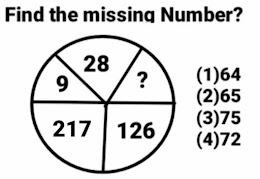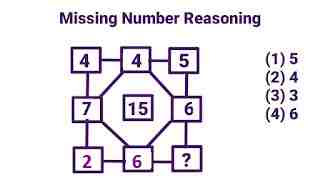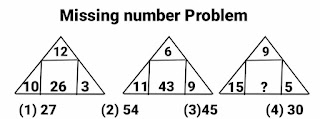Number Analogy Reasoning questions with answers for competitive exams
Ten Most Important Number Analogy Reasoning questions with answers for competitive exams have been discussed in this post . These types of problems are very helpful for cracking competitive exams like ssc cgl, ssc chsl and various Bank exams and many other similar exams. please feel free to comment your opinions about this post .
Number Analogy Reasoning questions with answers for competitive exams
Problem # 1
This box problem consist of four rows and four columns . And we have to find the value of question mark after studying the pattern of all the numbers in this box.
If we add any three numbers in any row then we shall have fourth number in the same row in respective of its position.
Formula:-
Sum of any three numbers in the same row = 4th number in the same row
1st Row
In this row we can add 1st, 3rd and 4th number then 2nd number will be the result of these number's sum.
5 + 6 + 9 = 20
2nd Row
In this row we can add 1st, 2nd and 4th number then 3rd number will be the result of these number's sum.
4 + 8 + 3 = 15
3rd Row
In this row we can add 1st, 3rd and 4th number then 2nd number will be the result of these number's sum.
9 + 7 + 9 = 25
4th Row
In this row we can add 2nd, 3rd and 4th number then 1st number should be the result of these number's sum.
7 + 8 + ? = 22
15 + ? = 22
? = 22 - 15
? = 7
Therefore correct option is (B) 7
Problem # 2
In these types of reasoning problem where numbers are written in any circle. Then we can write these numbers in a line to study the pattern of these numbers. Either these numbers are in increasing order or in decreasing order. Sometimes these numbers are written in different pattern.
Writting all the given number in increasing order. we get9 , 28 , ? , 126 , 217
All these numbers can be written as one more than the cube of continuous natural numbers starting from 2.
Formula:-
All the terms are one more than cube of some number.
1st Term = 2³ + 1 = 8 + 1 = 9
2nd Term = 3³ + 1 = 27 + 1 = 28
3rd Term = 4³ + 1 = 64 + 1 = 65(The value of Question mark)
4th Term = 5³ + 1 = 125 + 1 = 126
5th Term = 6³ + 1 = 216 + 1 = 217
Therefore correct option is (2) 65
Problem # 3
There are many method to obtain 49 from 5 , but we have to choose that method with the help of which we can obtain the value of question mark ?(out of four given option) from 7.
So if we split 5 in to 2 , 3 and then combine the squares of these numbers(2² & 3² ⇒ 4 & 9 ⇒49). Then we shell have the the value of the number on the left side of symbol :: i. e. 49.
Similarly if we split 7 in to 2 , 5 and then combine the squares of these numbers(2² & 5² ⇒ 4 & 25 ⇒425). Then we shell have the the value of the question mark i. e. 425.
Therefore correct option is (1) 425
Problem # 4
In this problem of reasoning we have to combine both the given numbers in left hand side in such a way that after applying any mathematical operation/operations we could get the number on the right hand side of all the three problems given above. Because in these types of reasoning problems we can change given mathematical sign according to our requirements.
Formula:-
Sum of both the digits of 1st numbers × Product of both the digits of 2nd numbers = Number on the right hand side
1st Problem
(3+7) + (2×8) = 10 + 16 = 26 ⇔ 62(After Interchanging both the digits of number(26) just obtained).
2nd Problem
(1+9) + (1×2) = 10 + 2 = 12 ⇔ 21(After Interchanging both the digits of number(12) just obtained).
3rd Problem
(6+8)+ (4×2) = 14 + 8 = 22 ⇔ 22(After Interchanging both the digits of number(22) just obtained).
Therefore correct option is (3) 22
Problem # 5
In this problem of reasoning we have to combine both the given numbers in the left hand side in such a way that after applying any mathematical operation/operations we could get the number on the right hand side of all the three problems given above. Because in these types of reasoning problems we can change given mathematical sign according to our requirements.
In any individual problem if we add all the digits which are on the left hand side then we can get the value of the number on the right hand side.
Formula:-
Sum of all the digits of both the numbers on the left hand side = Number on the right hand side
1st Problem
After adding all the digits present in this problem 23@35 can be written as follows
(2+3) + (3+5) = 13
2nd Problem
After adding all the digits present in this problem 24@13 can be written as follows
(2+4) + (1+3) = 10
3rd Problem
After adding all the digits present in this problem 13@31 can be written as follows
(1+3) + (3+1) = 8
Therefore correct option is (2) 8
This reasoning problem consists of three figures and every figure have four numbers associated to it . One numbers is at the centre of each figure and three numbers are at the corner of the each figure in the inner side . Look at last figure ,it have ? in its centre . So the solution of this problem is to find the value of question mark using three numbers associated to it .
Problem # 6
If we multiply 1st number of the given pair with 12 then we can have 2nd number in any of the three given option except one. And that fourth option which do not follow the rule will be odd one and will be the required answer.
Formula:-
1st number(Any Pair) × 12 = 2nd number(Same Pair)
1st Pair
10 × 12 = 120
2nd Pair
20 × 12 = 240
3rd Pair
14 × 12 = 168(This is odd one because its multiplication is given196)
3rd Pair
12 × 12 = 144
Therefore correct option is (3) (14, 196)
Problem # 7
In this reasoning problem 37 is related to 23 in the same way 19 will be related to ? , It means we have to apply same mathematical operations to 19 to get the value of ?.
1st Method
Taking the difference of both the numbers before and after :: sign ,The difference would be same in both the cases.
37 - 23 = 14
Similarly 19 - ? = 14
- ? = 14 - 19
-? = -5
? = 5
2nd Method
All the three numbers given in this problem are prime numbers so fourth will also be prime number. Therefore only one prime number out of given four options is 5.
Therefore correct option is (4) 5
Also Read these articles
This given reasoning problem having 9 numbers in it. Out of nine numbers ,one number in the middle of this figure and remaining eight numbers are in various positions.
To find the value of question mark (?) ,we can split this figure into four parts which includes these numbers
1st Part consists of upper left most number and two numbers which are around it (4 , 4 , 7)
2nd Part consists of bottom left most number and two numbers which are around it (7 , 2 , 6)
3rd Part consists of upper right most number and two numbers which are around it (4 , 5 , 6)
4th Part consists of bottom right most number and two numbers which are around it (6 , ? , 6).
Formula
Sum of all the three numbers in each part separated above = 15
4 + 4 + 7 = 1 (1st Part)
7 + 2 + 6 = 15 (2nd Part)
4 + 5 + 6 = 15 (3rd Part)
6 + ? + 6 = 15 (4th Part)
12 + ? = 15
? = 15 - 12
? = 3
Problem # 9
But the biggest problem is how to utilised these four numbers to get the value of this question mark?
Now watch carefully the 1st two figures . Since these figures have some values at middle.
Now we have to find or search the formula for these three numbers in each figure to utilised them in any possible way to get middle or central number.
The same formula will be applicable to third figure to find out the value of question mark.
Formula :-
The product of two numbers of the right side of each triangle is equal to sum of two numbers on the left side of each triangle.
1st Triangle
12 × 3 = 26 + 10 = 36
2nd Triangle
6 × 9 = 43 + 11 = 54
3rd Triangle
9 × 5 = ? + 15 = 30
? + 15 = 30
? = 30 - 15
? = 25
Therefore correct option is (4) 25
2nd Method
Formula :-
The middle Number in each figure is equal to product of two left most numbers minus number on the right side.
1st Triangle
{( 12 × 3 ) - 10 } = ( 36 - 10) = 26
2nd Triangle
{( 6 × 9 ) - 11 } = ( 54 - 11) = 43
3rd Triangle
{( 9 × 5 ) - 15 } = ( 45 - 15) = 30
Therefore correct option is (4) 30
Problem # 10
This reasoning problem also consists of three figures and every figure have four numbers associated to it . One numbers is at the centre of each figure and three numbers are at the corner of the each figure. Look at last figure , it have ? in its centre . So the solution of this problem is to find the value of question mark using three numbers associated to it .
But the biggest problem is how to utilised these four numbers to get the value of this question mark?
Now watch carefully the 1st two figures . Since these figures have some values at middle.
Now we have to find or search the formula for these three numbers in each figure to utilised them in any possible way to get middle or central number.
The same formula will be applicable to third figure to find out the value of question mark.
Formula :-
The middle Number in each figure is one tenth of product of remaining numbers.
Middle Number = abc/10
1st Triangle
(15 × 6 × 5)/10 = 450/10 = 45(Number in the middle of 1st triangle)
2nd Triangle
(7 × 6 × 5)/10 = 210/10 = 21(Number in the middle of 2nd triangle)
3rd Triangle
(20 × 30 × 1)/10 = 600/10 = 60(Number in the middle of 3rd triangle)
Therefore correct option is (2)60
Conclusion
So these were the Ten Most Important Reasoning questions with answers for competitive exams of number analogy with solutions were discussed in this post . These types of problems are very helpful for cracking competitive exams like ssc cgl, ssc chsl and various Bank exams and many other similar exams. Please feel free to comment your opinions.


















Nice
ReplyDelete